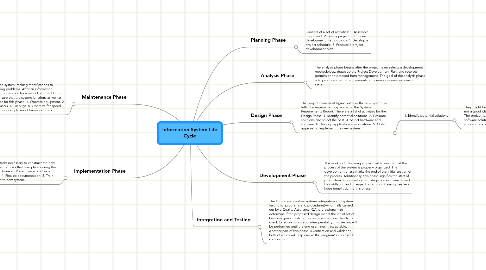Information System Life Cycle
da gvidas astromskas


1. Maintenance Phase
1.1. Involves day-to-day operation of the system, making modifications to improve performance, and correcting problems. After an information system is implemented, it remains in operation for a period of time. During this time, maintenance activities ensure that the system functions as well as possible. There are a list of activities for this phase: 1. Operate equipment. 2. Make backups. 3. Provide help to users. 4. Fix bugs. 5. Optimize for speed and security. 6. Revise software as necessary to meet business needs.
2. Implementation Phase
2.1. The project team supervises the tasks necessary to construct the new information system. There are a set of tasks that take place during this phase: 1. Purchase and install hardware and/or software. 2. Create applications. 3. Test applications. 4. Finalize documentation. 5. Train users. 6. Convert data. 7. Convert to new system.
3. Integration and Testing
3.1. The fifth phase involves systems integration and system testing (of programs and procedures)—normally carried out by a Quality Assurance (QA) professional—to determine if the proposed design meets the initial set of business goals. Testing may be repeated, specifically to check for errors, bugs and interoperability. This testing will be performed until the end user finds it acceptable. Another part of this phase is verification and validation, both of which will help ensure the program"s successful completion.
4. Development Phase
4.1. This work includes using a flow chart to ensure that the process of the system is properly organized. The development phase marks the end of the initial section of the process. Additionally, this phase signifies the start of production. The development stage is also characterized by instillation and change. Focusing on training can be a huge benefit during this phase.
5. Planning Phase
5.1. Consists of a set of activities: 1. Assemble the project. 2. Justify project. 3. Choose development methodology. 4. Develop a project schedule. 5. Produce a project development plan.
6. Analysis Phase
6.1. The analysis phase begins after the project team selects a development methodology, draws up the Project Development Plan, and receives permission to proceed from management. The goal of the analysis phase is to produce a list of requirements for a new or revised information system.
7. Design Phase
7.1. The project team must figure out how the new system will fulfill the requirements specified in the System Requirements Report. There are a list of activities for the Design Phase: 1. Identify potential solutions. 2. Evaluate solutions and select the best. 3. Select hardware and software. 4. Develop application specifications. 5. Obtain approval to implement the new system.
7.1.1. 1. Identify potential solutions
7.1.1.1. They might be more effective, less costly, or less complex. Therefore, it is not a good idea to proceed with the first solution that comes to mind. The project team should instead identify several potential hardware and software solutions by brainstorming and researching case studies at web sites and in computer publications.

